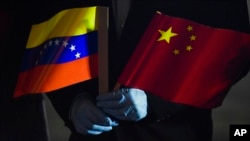China now leads the world in trade with Africa and in direct investment in parts of Asia, but despite rapidly increasing its trade and investments with Latin America it still lags behind the United States with no immediate chance of displacing it.
Latin America stands out from other regions where China has invested due to its more protectionist government policies plus a long legacy of U.S. economic involvement that’s less obvious in other parts of the world, analysts say.
Data show that “China has become an emerging investment partner for Latin America, but it does not appear to be an immediate threat to traditional investors in the region,” the Boston University Global Development Policy Center said in a study earlier this year.
This week, a group of U.S. government officials is in Latin America scouting infrastructure projects for the Group of 7’s plan for the group’s “Build Back Better World,” which was announced in June and seen as an alternative to China’s Belt and Road Initiative building infrastructure projects in the developing world. The Group of 7, or G-7, comprises wealthy, highly industrialized nations.
Some economists have raised concerns over China's lending practices, saying countries can take on too much debt for massive projects that do not justify their cost.
Chinese investment in all-new projects in Latin America rose from 4% of all sources between 2005 and 2009 to 6.8% over a five-year period ending in 2019, the database fDi Markets has calculated. In a bellwether case, China began investing in Chile just five years ago and it’s now the South American nation’s top source of foreign capital, said Jorge Heine, the former Chilean ambassador to China.
The United States has held steady as the region’s top investor at around 22% of all foreign sources. American consumers rely on Latin America for agricultural goods while Mexico, the region’s second most populous country, counts the United States as its biggest direct investor.
China’s share of mergers and acquisitions in Latin America rose from 2.4% over the five years to 2009 to 16.3% between 2014 and 2019 – second after the United States, according to data from the analytics service DeaLogic.
On the trade side, the region’s $16 billion in trade with China in 2000 has grown to more than $400 billion, Heine told VOA.
But Chinese firms have found it harder in Latin America than in Africa or Asia to win government contracts, pay bribes or win over local communities concerned about environmental preservation, analysts say. They’re often barred from taking resources or any direct proceeds from resource extraction industries, said Yun Sun, co-director of the East Asia program at the Stimson Center in Washington.
“Latin American countries are very protective of their natural resources, so they don’t usually let China into the asset or into the equity of, for example, the mineral resources,” Sun said.
Trade and investment
In Latin America, analysts say China mainly is looking for food, oil, refinery investments and minerals – such as the mobile phone battery ingredient lithium. Chinese investors have focused mostly on Argentina, Brazil, Chile and Peru, the Boston University study says.
State-owned companies are investing in the energy sector of Brazil, Latin America’s biggest economy, for example. In Panama, the Chinese Landbridge investment consortium intends to spend $1 billion for a new container port that would support Chinese vessels.
But a lot of common merchants still identify the United States as their major market. Artisans from Guatemala, the source of brightly colored hand-woven fabrics, sell more wares to Americans because of their willingness to buy, Loreda Gomez has found. Gomez has run the Guatelinda crafts market in Oakland, Calif., for three years.
Consumers from the United States use the fabrics as tablecloths, shop for keychains with an indigenous Guatelaman design and seek out the Central American country’s tableware, said Gomez, herself from Guatemala. Chinese seldom buy her goods.
“Their students come in and though they can’t find the right sizes, they like what we have, the hand-woven textiles and T-shirts for men that are hanging up here, that’s all we’d have for now,” Gomez said. But in Guatemala, she recalls, lots of plastic household items are made in China.
Risks to Latin America
China isn’t consciously competing with the United States for influence in Latin America, experts believe. It’s looking to the region for “alternative resources” as part of its global expansion of investment over the past decade, said Song Seng Wun, an economist in the private banking unit of Malaysian bank CIMB.
“From the Chinese side they do have the scale,” Song said. “They’re very targeted in terms of what they want for their own benefit plus obviously how it benefits their business.”
China represents an “economic opportunity” for the Americas, the Boston University study says. “China is buying as top traditional partners in the region are also selling, and it appears to be filling in some spaces,” it says. But it’s a “challenge” as well, the study adds.
China’s investment in needier countries can tilt Latin American governments away from U.S. favor, said Evan Ellis, a research professor of Latin American studies at the U.S. Army War College Strategic Studies Institute. He points to oil-rich Venezuela, which has accepted Chinese loans and sold oil to China.
“In pursuing its own goals, China ends up profoundly affecting the political as well as the economic character of the region in terms of who benefits and by extension ends up profoundly affecting the security and situation of the United States,” Ellis said.




